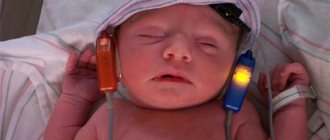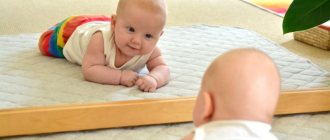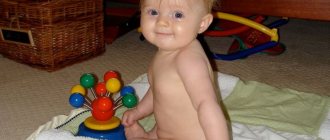A child is a long-awaited miracle in every family. They prepare for his appearance in advance and lovingly study any information: books, articles, information on the Internet.
But books read and theoretical information from the Internet will not be able to answer all the questions that young parents will have with the birth of their baby. And one of the main questions is when does a newborn begin to see?
What should a 2 month old baby do?
The capabilities of a child at 2 months should be considered in terms of physical and psychological. By the age of two months, the baby experiences the following changes:
- Two months is the time when the baby can independently and confidently raise his head. Moreover, lying on his stomach, the baby turns his head towards the sound.
- Coordination of movements becomes clearer. This is due to the disappearance of increased muscle tone. Now the child makes attempts to reach visible objects, making voluntary movements with his limbs.
- Studying the world around you and, above all, yourself. The baby can watch his arms and legs for a long time, shake the rattle placed in his hand.
- A 2 month old baby is cooing. These first sounds are vowels. They are still short and short-lived. The baby makes them and listens himself. Soon these sounds will replace syllables.
- He tries to roll over from his side to his back, and he succeeds.
- Can distinguish between day and night, reacts to changing weather conditions. Knows his bedtime and wakes up at approximately the same time. They may react to changing weather conditions by prolonged crying, restless sleep, or excessive activity.
Sometimes parents think that a 2-month-old child is trying to sit up. This is not entirely true. The baby's bones, muscles and joints are completely unprepared for such an impact. There's no need to rush. The vertical position expands the boundaries of visibility, but a two-month-old baby does not need this now. In order for the child to sit down at the right time, it is necessary to lay him on his stomach as often as possible. In this position, when raising the head, chest, arms and shoulders, the muscles that are necessary for mastering the skill of sitting will be strengthened. Therefore, to the question: is it possible to place a child at 2 months, the answer is categorical - it is impossible.
How does a 2 month old baby see?
At birth, the child's vision is quite developed. Therefore, the absence or presence of light does not remain without his attention. The first few days the baby sees everything around him as if in a fog. What do babies see at 2 months? The baby can see large objects located nearby. The baby's visibility distance is up to 30 cm. Therefore, he remembers the face of the mother who is feeding the fastest. At the age of two months, a child is able to distinguish between three-dimensional and flat, concave and convex objects. The baby's eyes are still squinting, but this will soon pass. Usually by the age of six months the position of the eyes is normalized. A child’s vision at 2 months reaches a new level because the ability to concentrate on a stationary object appears. Parents are wondering what colors children can distinguish at 2 months? The first months of life, the baby sees white and black. Therefore, toys and objects in black and white attract children's attention. Only this contrasting combination is observed by the child up to 3 months. Afterwards, the ability to distinguish some primary colors appears. A child’s achievements at 2 months are of great importance for further development. Timely acquisition of skills will ensure successful completion of subsequent tasks and goals.
Vision is an extremely important function of the body. Thanks to vision, a person sees the world around him and himself in it. It is vision that allows us to perceive the beautiful and the ugly, colorful and faded, bright and dull, experiencing the world in all its diversity. His development largely depends on how a child sees.
When we talk about vision, we usually mean the eyes. But the eye
- This is
the peripheral part of the visual analyzer
, which also includes
the optic nerves
and
cerebral cortex
. The eye perceives the image and translates it into nerve impulses, which are carried along the optic nerves to the cerebral cortex, where they are processed and the image is formed. The interaction of these components of the visual analyzer gives vision.
WHAT AND HOW DOES A BABY SEE?
Eyes are formed in the third week of intrauterine development and develop throughout pregnancy. The intrauterine vision of a child has been studied very little, but it is known that even a baby born at 28 weeks of pregnancy reacts to bright light. In addition, it is considered proven that a reaction to bright light appears in a child before birth - in the womb. A child is born with an immature visual analyzer (its formation is completed only by the age of 10-11).
There is an opinion that a newborn sees the world upside down - is this true? If we abandon speculation and operate only with facts, the situation is as follows. Just like in an adult, on a baby’s retina the image is actually displayed upside down (this is an objective optical law). It has been established that the cerebral cortex, which analyzes the image, has “adapted” to turning the picture over. It is impossible to say whether a person is born with this skill or acquires it over time: after all, the baby will not complain about the undignified behavior of the mother, who for some reason turned upside down. Therefore, all discussions on this topic, caused by the understandable desire to recreate the picture of the world as seen by a person who has just arrived in it, are of no scientific or practical interest.
Immediately after birth
The baby is literally bombarded with a huge amount of visual stimuli as he moves from the dark womb into the bright world around him.
A newborn has very poor vision: he sees only large objects located in close proximity to him. There is a deep meaning in this. Nature, as it were, protects the baby from excessive visual stimulation, allowing him to isolate the most important thing from the huge, diverse world: his mother’s face. And indeed, he sees best at a distance of about 40-50 cm - this is exactly how far away the mother’s face is from the baby during feeding. It is recommended to place toys no closer than 40-50 cm from the newborn’s face.
If you show a newborn a bright toy, he will not stop looking at it. But already from the second week of life, gaze fixation
- its short-term delay on objects. However, the baby is not yet able to concentrate for a long time. When his gaze is not fixed on any object, he may experience apparent strabismus - uncoordinated eye movements. In fact, this phenomenon has nothing in common with true strabismus, representing a normal manifestation of the functional immaturity of the visual analyzer. This, however, does not mean that true strabismus does not occur in newborns - only an ophthalmologist can correctly assess the condition of the child’s visual apparatus.
Binocular gaze fixation
(an object is fixed with both eyes) appears at 2-3 months of life. At this age, eye movements become coordinated and “squint,” if it was apparent and not true, disappears. From 2-3 months, the child begins to recognize the mother, and then other close people, reacting to their appearance in his field of vision with a smile and general motor activity. Visual acuity increases significantly during the first year of life. By the sixth to eighth months, children begin to identify simple geometric shapes with their eyes against the general background, and from the age of 1 - more complex designs.
Color perception
. In addition to the myth of the “upside down world,” there is another legend that is quite firmly rooted in the minds of many, concerning the vision of a baby. Very often you can hear that a newborn baby has black and white vision and only over time the world becomes colored for him with different colors. This is not true, although there is some truth in this misconception - as in most others. As we have already said, the same “picture” is displayed on the retina of a newborn as on the retina of an adult. However, the baby begins to focus his gaze selectively, gradually isolating certain colors from the surrounding reality. Goethe wrote: “The color yellow pleases the eye, expands the heart, invigorates the spirit, and we immediately feel warmth. Blue color, on the contrary, represents everything in a sad way.” Intuition did not fail the author of “Faust” - indeed, first of all, children begin to fix their gaze on objects of a yellow-green color scheme, but very soon other colors join it.
WHAT DEPENDS ON PARENTS?
Moms and dads must remember that very, very much depends on them - including the development of the child’s visual functions. I would like to give a few practical recommendations:
1. The eye is an organ that is very sensitive to the influence of internal and external environmental factors. The task of parents is to take care of the general health and proper nutrition of the baby.
2. The child must be in a well-lit room - take this into account when choosing a room for the nursery.
3. For the proper development of the visual apparatus, a child needs a sufficient number of visual impressions. The baby should be surrounded by bright objects of different shapes and sizes. These can be not only expensive toys bought in a store, but also homemade garlands or balls made of paper or fabric of different colors - the fruit of your imagination. It must be remembered that at an early age they should be located at a considerable distance from the child (40-50 cm). And one more thing: it is advisable to periodically change the toys surrounding the child.
VISIT TO AN OPHTHALMOLOGIST
Unfortunately, various eye diseases can occur in infants. The most common causes of congenital diseases are:
- adverse environmental influences;
- maternal diseases during pregnancy: previous rubella
- tuberculosis
- viral diseases;
Pathological changes in the organ of vision can be observed in newborns with congenital toxoplasmosis. Sometimes parents can suspect a particular eye pathology based on the child’s appearance. For example, they may notice ptosis (drooping) of the upper eyelid; microphthalmos (shrinkage of the eye); macrophthalmos (enlargement of the eye), which occurs with congenital glaucoma; clouding of the cornea (the so-called “thorn”) and the lens (“white pupil”) - with congenital cataracts. Redness of the eyes and eyelids also indicates trouble. An attentive mother will not miss strabismus in her child (we wrote about physiological and true strabismus above). Sometimes newborns have bluish-red spots on the skin of the face and eyelids. This is telangiectasia (uneven dilation of small vessels). As a rule, the spots disappear on their own within a few months. However, if the number of such spots does not decrease over time, but increases, you should consult a doctor to rule out a benign vascular tumor (hemangioma).
And yet, it would be a deep mistake on the part of parents to believe that an attentive attitude to the child is a guarantee of identifying any eye disease. Let's take, for example, the most aggressive and severe of these diseases, which poses a threat to the life of a child - retinoblastoma, a congenital malignant tumor of the retina. As a rule, an ophthalmologist may suspect this tumor in the maternity hospital or during the first examination of the child in the clinic. Parents, not armed with special knowledge and tools, may notice changes in the form of a white or greenish glow of the pupil only in the later stages of the disease. We dwelled on this formidable disease not at all in order to scare, but precisely because with its early diagnosis and proper treatment, it is possible to save not only the life of the child, but also, in some cases, the eye with residual vision. In addition, by the appearance and condition of the eyes and its individual structures, the doctor can judge with great certainty the condition of the body as a whole. For example, congestive optic discs appear when intracranial pressure increases. This condition requires immediate consultation with a neurologist. The ophthalmologist is often the first specialist who may suspect metabolic disorders, pathology of the kidneys, cardiovascular system, congenital infections (for example, rubella, syphilis, tuberculosis, toxoplasmosis). The conclusion suggests itself - a visit to an ophthalmologist in the first months of a child’s life should under no circumstances be neglected! Only an ophthalmologist can examine a child, make a correct diagnosis and prescribe treatment. He may resort to conservative therapy, or may recommend surgery. For example, congenital cataracts and glaucoma can only be treated surgically. The doctor determines treatment tactics individually in each specific case.
The child should be shown to an ophthalmologist for the first time at three months of age, the second time at 6 months, and the third time at 1 year. What examinations does an ophthalmologist perform?
- General examination (the doctor evaluates how the baby’s eyes move and how the baby’s eyelids close).
- Preliminary assessment of vision (does the baby react to light, at what distance does he see objects).
- Determination (using special skiascopic rulers) of refraction - the refractive power of the optical system of the eye (myopia, farsightedness, astigmatism). It should be noted that for children under three years of age, normal refraction is farsightedness. The ophthalmologist determines the degree of refraction. For example, with a high degree of farsightedness, correction with glasses is necessary to prevent strabismus and amblyopia (low vision due to functional underdevelopment of the visual organ). If necessary, glasses are also prescribed for children under one year old.
- And finally, examination of the deep media of the eye and fundus using an ophthalmoscope and a slit lamp.
I would like to draw your attention to the fact that examination of children is imperative
It is carried out with a wide pupil (to dilate the pupil, special preparations are used that are instilled into the child’s eye).
If, before the examination, your child was not given pupil dilation drops in his eyes 1
, you should find out from your doctor the reason for this.
I wish you that your baby looks at the world with healthy and happy eyes - this depends to a very large extent on you!
The birth of a baby is always a pleasant and solemn event in a young family. From the first days, new parents have a lot of worries and questions. How does vision adaptation occur and when does a newborn begin to see? What can differentiate, at what age does he recognize mom and dad?
Newborn eye diseases
Vision pathology in children in the first months of life appears due to abnormal intrauterine development. Infections suffered by the mother during pregnancy have a negative effect on the baby's health. Some eye diseases are detected immediately after birth, others - during subsequent examinations.
Strabismus
All children under 3 months of age have cross-eyed eyes. But if the strabismus remains, then urgent action must be taken. The causes of pathology are associated with:
- hereditary predisposition;
- myopia;
- infectious diseases;
- heavy loads on the visual apparatus.
Strabismus can be identified by the way the eyes move. For some they are too fast, for others they stand still. It can be seen that one eye stands still and the other moves. Therefore, strabismus can be determined visually. Children complain of poor vision and pain. The image appears double, which is why the child quickly gets tired when looking at a book or drawing. The disease can be successfully cured in some cases, but sometimes surgery is required.
Congenital myopia
Children in the first year of life are diagnosed with myopia, or myopia. It occurs in the intrauterine state. It is determined immediately after the birth of the baby by changes in the size of the eyeball and shape. It is oval in shape, slightly retracted. The presence of myopia in an infant is indicated by the fact that he squints his eyes, trying to see an object in the distance.
When looking at toys, he brings them close to his face. At an older age, the child will complain of pain in the eyes and get tired when working with a book.
Blindness
Visual function is absent in children when atrophy of the optic nerve occurs as a result of damage to the nervous system in fetal development, intoxication and infections of the mother. Asphyxia during childbirth causes damage to the visual center of the brain. And then the child sees, but the brain does not perceive or analyze what he sees.
Drooping of the upper eyelid
There is partial and complete prolapse of the upper eyelid in newborns. Both one eye and both are affected. The disease is associated with heredity. The neurogenic nature of the disease is also determined. The disorder can be determined by the way the child looks up. He lifts his head strongly to examine the suspended object.
Infant hyperopia
Pathology can be determined as early as possible only by examining visual acuity. The child has difficulty distinguishing objects located nearby. He strains his eyesight, develops headaches, and increases fatigue. To stop the development of farsightedness, you need to consult an ophthalmologist. Sometimes timely correction corrects the violation. Use glasses for this.
Nystagmus or shifty eyes
If children have problems with fixating their gaze, this indicates a serious illness - nystagmus. The child is unable to control the movement of the eyeball. This is usually associated with the development of dystrophic processes in the retina of the organ, atrophy of the optic nerve. Newborns often suffer from nystagmus. The disorder goes away on its own, but if the central nervous system is affected, this can cause many ophthalmological diseases.
Congenital glaucoma
This visual defect is rare and is diagnosed immediately by measuring intraocular pressure. The main signs of the disease include:
- increased blinking;
- increase in the size of the eyeball;
- lacrimation;
- photophobia.
If glaucoma is detected early, vision can be restored. In some cases, the disease threatens complete blindness.
How do newborn babies see after birth?
For the first few weeks, the baby only eats and sleeps. And many parents think that his vision is at a developmental stage. But pediatricians say that a child begins to see from the first minutes after birth.
Features of vision: from 1 to 6 months:
- 1st month.
Vision is blurred, without clear focus on the object of interest. A newborn's eyes are just beginning to get used to the new world. He sees clearly only at a distance of 15-20 cm. Very often you can notice how after birth a child squints his eyes, thereby covering his corneas from bright light; - At two months.
The ability to focus the gaze on one thing for only a few seconds, but the gaze is not yet stable and sliding (floating); - 3-4th month of life.
The ability to look at an object of interest and follow its movement (children's toys, people close to him). At three months of age, a newborn can already distinguish colors. One of the first are shades of red and yellow; - Six months.
At 6 months of age, the child recognizes his loved ones and their special features (mustache, beard, tattoos). They especially prefer to look at various color patterns, paintings, and photographs.
At what weeks (months) do babies begin to see well?
Adaptation of viewing perception in children occurs gradually. In the first month, the baby closely examines and studies his mother's face. At such moments, his gaze is not focused on one object. The baby sees objects located near him, but is not yet able to concentrate his attention on one.
Let's look at what a newborn sees after birth (by week):
- 1-4 weeks – vision is unclear and blurry (as if in a fog);
- 6-8 – able to hold his gaze on the objects around him (up to ten seconds);
- 16 weeks – ability to track the movement of objects and people. At this age, the baby is able to recognize mom and dad, smile, make sounds and coo;
- 24 week (6 months) – sees well in an upright position. At six months, the baby focuses his eyes intently on his favorite toys and small objects. In addition, his vision is able to distinguish the faces of mom, dad, close relatives and strangers.
What does a child like to look at?
It has been noted that infants at 3 months of age love to observe what is happening, developing their worldview:
- Most of all, a newborn focuses on the faces of his parents. He recognizes mom and dad, looks at the characteristic facial features, and therefore reacts negatively and emotionally to people he doesn’t know.
- A sudden change in appearance is a subject of particular interest and observation in children. For example, if dad shaved his beard, grew a mustache, or shaved his head, this can cause dissatisfaction and loud crying.
- After 2 months, the child looks with interest at patterns on wallpaper, black and white figures, photo pictures and other bright objects.
Changes in vision by three months
Children begin to see their surroundings more or less clearly and realistically, but still not in our usual colors, but in black and white. They have already examined and remembered the closest people who often caught their eye - mom, dad, sisters, brothers - and are even able to distinguish them from each other.
This is especially easy if relatives have special features. For example, dad has a dark mustache/beard, mom is fair and wears glasses, sister is fair but smaller than mom, brother also has a small face, but dark and without a mustache/beard.
At three months, temporary strabismus can again be observed. This is the result of imperfection of the eye muscles, which by this age have not yet become stronger. In order to force both eyes to simultaneously look at a certain object, even if it is not moving, considerable effort is required from a small person.
How to establish contact with your baby?
The gradual development of a newborn's visual abilities is possible only with the direct participation of parents. What needs to be done to attract attention and establish contact with him?
To create conditions for your child that can improve his visual perception of the environment, observe the following nuances and subtleties:
- It is easier for a baby to focus his gaze when in an upright position. Hold your little one upright as often as possible, especially after feeding and while awake;
- look closely at the eyelashes, sometimes they may not grow evenly, which can lead to damage to the eyelashes and distortion of vision;
- the objects in question should be at the optimal distance for the baby’s vision (no further than 25 cm);
- Hang the cradle and rattles correctly near the crib. Children's play accessories should be hung to the side, not opposite the child's head. Another option is to hang toys in the legs. In this position, the baby will better see the object in question, without straining the neck muscles.
So, we looked at the main stages of vision development in children after their birth. Now that you know how a newborn sees, the peculiarities of his visual sensation, you don’t have to worry too much. However, only a qualified doctor can understand whether vision is developing correctly and whether there are deviations from the norm.
A child is a whole unknown world that raises many questions, sometimes the most unexpected. There is especially a lot of anxiety associated with very young children – newborns. For example, for some reason, many people believe that after birth the baby has not yet developed the function responsible for vision. Naturally, it immediately becomes interesting - when will the world around him be available to him in all its colors? The following information will help you understand your baby’s ability to see after birth.
Features of visual function in newborns
As it turned out, babies begin to see from the first days of their lives. Another question is what can they see and how does it happen?
The myth that a newborn child cannot see anything occurs because many children still have very poor vision after birth, and the world appears blurry and cloudy to them. In addition, in the first days of his life, the baby sleeps almost all the time and rarely opens his eyes. It seems that he is not interested in anything, due to the fact that he does not see the world around him.
But in fact, in the initial period after childbirth, the child adapts to new conditions, including his visual function. Bright light is still unusual for them, and the baby’s eyes quickly get tired of it. But gradually they get used to it. The newborn begins to open his eyes more often and for longer periods of time. Some people may also experience swelling of the eyelids, which bothers them, but there is no need to be afraid - this goes away quickly.
Menu 9 months baby while breastfeeding
Should I rush to see a doctor?
this is approximately how a child perceives the world month by month
When a child begins to see, it is necessary to see an ophthalmologist as early as possible - he will be able to give professional recommendations regarding proper eye care even from the first day of birth. Do not be intimidated by the complexity of the procedures - as a rule, everything is simpler than it seems at first glance.
Of course, if the baby does not have problems with neonatal conjunctivitis, which sometimes happens in the first week of life. In this case, both or one eye begins to fester, but this attack is easily curable and in no case affects visual acuity in the future.
What can a newborn see?
For a newly born baby, the world seems blurry and somewhat vague. This is completely normal; at the age of one year, vision returns completely to normal. The most optimal distance at which a child begins to see is about 20–25 cm, thus the image becomes clearer.
By the way, a rather interesting fact is that it is at this level that the baby’s face is located when breastfeeding.
The first thing a baby begins to look at after birth is the face of mom and dad. He may even get upset and cry if his parents' facial expressions change dramatically. The fact is that the child is accustomed to a certain appearance, and any sudden changes can frighten him. Even newborns are interested in a variety of black and white patterns and objects, which he studies with pleasure.
As for the color palette, the newborn is able to distinguish only black and white tones, and the picture itself seems gray to him.
The ability to see colors appears in the third month of life.
It is then that he finally develops the ability to focus his gaze on any objects. It is important to understand the difference that seeing colors and distinguishing between them are two different things. The task of parents is to give an idea of certain color tones, but this should not be done immediately after birth.
As mentioned above, in the earliest period of life, the child begins to see 2 colors - black and white. The first bright colors a newborn is introduced to are red and yellow, this happens between 2 and 3 months. The main color scheme is revealed to the baby only in the 4-5 month age period. It is important to understand that a child sees pure colors, without distinguishing shades, and only with the onset of his first anniversary, all shades become accessible to his vision.
How to care for your baby immediately after birth and during the first year of life
So, if we highlight several periods of formation of the child’s visual function, we get the following:
- During the period when the child has just been born, he is already able to distinguish and respond to light
- The world itself seems somewhat blurry for the baby, and from it he is able to see only large black and white objects at a distance of no more than 30 cm
- Gradually, the baby begins to notice movements (for example, facial expressions of parents, shifting an object)
- The period when a child turns 2-3 months old is significant in that he is already able to distinguish between 2 colors and follow (moving) toys.
- At 6 months, the ability to observe small objects appears, and the child begins to recognize mom and dad
- When the baby turns 1 year old, the ability to distinguish shades appears
Progress in the first half of the year
Around the sixth month of life, the baby is able to not only begin to distinguish family members, but also recognize them, greeting them with a happy smile and cooing. The basic color scheme is already available to him, but rich yellow and red colors attract attention more than others.
That is why it is recommended to buy your first rattles and teethers in this color - they will definitely attract and hold attention. By six months, a child’s eyes look familiar to us and should not squint.
If even a slight squinting of at least one eye is noticed, this is a reason to contact your family pediatrician, who, after an examination, will tell you whether there is a need to visit an ophthalmologist.
Young mothers, especially those with their first child, are prone to excessive anxiety and may exaggerate some symptoms. For example, due to genetic inheritance, a baby may have a wide bridge of the nose, which creates the erroneous impression of squinting eyes.
A pediatrician can debunk such a misconception, while reassuring worried parents. Your baby's vision can be checked at home using a simple test. You need to take a small flashlight with a not very bright light, direct its beam into your eyes, holding the flashlight itself at the level of the bridge of your nose at a distance of 20-30 cm from your face.
You need to monitor the glare of the beam in the pupils: if it is in the middle, then there are no problems with vision, but if the glare deviates in any direction, you need to consult a professional.
Physiological features of infant vision
It should be remembered that after a child is born, he begins an adaptation period. The baby sleeps a lot and wakes up mainly to eat. The eyes also need to get used to the new conditions. Therefore, in the first week of his life, a newborn cannot focus his gaze on anything for more than 3-4 seconds. By 2 months, the baby’s gaze does not yet stop at a specific object, but becomes more stable. Gradually, the time interval increases and by 4 months it is almost completely formed.
Many people are frightened by such a phenomenon as strabismus in newborns. You should be aware that this is the norm for such young children, because... Not everyone's eyes are able to work together yet.
The fact is that the eye muscles are not yet developed enough, so this happens involuntarily, and by about six months it completely goes away (sometimes by 1 year).
You should contact a specialist when this phenomenon occurs too often. You can conduct a small test - shine a flashlight into the child’s eyes and observe how the light reflections are located. If there is no pathology in the center of the pupil, then it is better to consult a specialist to check the muscles of the eye.
How to prevent constipation in newborns when bottle-fed
So, the exact answer to the question of when a child’s vision appears will be this - before his birth, and, accordingly, immediately after he was born. But an adaptation period begins for the child, therefore, it is much more important to know what and how the baby is able to see.
It is often said that for several days a newborn child does not have the opportunity to see the world around him, as well as hear various sounds. But this is a misconception or rather a myth.
The need for specialist consultation
Parents will not be able to diagnose their baby on their own, so you should visit an ophthalmologist when the child is six months or a year old. A disease such as congenital glaucoma is best identified as early as possible. If this is not done, the baby may lose an eye. For those born prematurely, it is necessary to check the visual apparatus more often to prevent retinopathy. Only a visit to a pediatric ophthalmologist will prevent the development of serious pathologies of the organ of vision.
When, what and how newborns see
The baby's visual organs work as expected from the very first moment of birth. Most newly born children can see the objects around them through a kind of fog and blurriness. In this way, gradual adaptation of the visual organs occurs. A child has a reflexive tendency to squint his eyes or keep them completely closed. But you can also meet babies who, for some time after birth, keep their eyes open, and you can even notice in them some interest in what is happening.
What does a newborn see?
- The ability to respond to bright lighting or its complete absence.
- The ability to distinguish some larger objects from the overall picture.
- The ability to monitor the movement of large objects, including people.
- When a child reaches the age of three or four months, the ability to follow objects and toys that are in motion appears.
- At six months, a child can closely observe smaller objects, and even distinguish between them, recognizing his toys.
What does your baby like to look at?
- The most favorite things that babies love to look at are the faces of their parents. Most often this is the face of the father, who has more distinct features.
- Changes in the appearance of parents can cause anxiety and some dissatisfaction in the child. At the same time, children often begin to be capricious, turn away, or even cry.
- Love for a variety of pictures and photographs, especially black and white.
How do newborn babies see?
- During the first week of a baby's life, he may look at the same thing for several seconds.
- At the age of two months, the child is already able to focus his gaze on an object for a short time.
- At four months, the baby can already fully focus on the subject that interests him.
- Often in young children you can notice how they slightly squint their gaze. This happens due to the inability to use both eyes at the same time. This can be considered normal until six months of age. If you further discover such a deficiency, you should definitely contact a specialist.
How to make contact?
- Newborn babies focus their eyes much better if they are in an upright position.
- You need to be patient and wait for the baby to focus his gaze.
- A newborn baby sees objects and faces that are no further than 20-25 cm.
- It is best to hang toys above the playpen or crib not in front of the baby’s face, but on the side or near his legs.
Knowing all the nuances and subtleties of how and when your baby begins to see, you can easily find a common language with him and easily establish your first contact. This is very important not only for parents, but also for the baby himself.
Features of vision in the first days of life
You cannot expect that a baby just surviving birth will have the vision of an adult. The picture of the world is still very blurry for him, and even painful, since the bright light unusually hurts his delicate eyes. Therefore, often after birth, babies are kept in rooms with dim lighting to minimize stress.
It is worth noting that from the very moment of birth, it is most convenient for a baby to view everything and everyone around him from a vertical position. This makes it easier for him to concentrate, although a child will only be able to hold his gaze on something for at least 10 seconds after four months. And before that, his eyes will be able to focus for only a couple of moments, and will seem to “slide” over the object of interest.
At the beginning of his life, the child only sleeps, eats and wets diapers. Although it is interesting to examine the space around him, it is still unpleasant and uncomfortable due to swollen eyelids and reddened eyes. The swelling appears when passing through the birth canal during the process of delivery, but goes away on its own after some time without outside intervention. Most often, the eyelids are half-closed and squinted during wakefulness.
There is an opinion that newborns see everything upside down. This is not true: they are unable to analyze what is in front of them until they perceive what they see. It has been proven that newborns can see at long distances. The baby best distinguishes objects at a distance of about 25 cm - this is the space from the baby’s eyes to the mother’s face during breastfeeding.
Therefore, even with artificial feeding, it is recommended to take the baby in your arms - this is how it is most comfortable for him to look at his mother and remember her features. And even at such a tender age, you can and should make eye contact and attract attention. True, in order to succeed, considering how newborn children see, several conditions must be met:
- First of all, catch the right moment - not immediately after feeding or when the baby is about to fall asleep.
- Lift, supporting by the head and under the butt, at arm's length.
- Do not make sudden movements, give the child time to concentrate his gaze.
- Smile: positive emotions are always more pleasant to observe.
- When trying to attract attention, you should not raise your voice: the baby may get upset, become capricious, start crying, and then you should not expect a positive result from eye contact.











